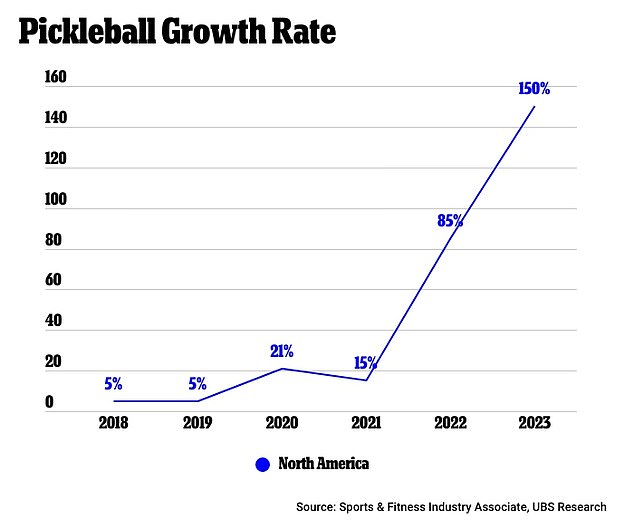Doctors Warn Pickleball Could Leave You BLIND – The Agile Ball Can ‘Bypass Protective Eye Socket’
Pickleball has crossed America.
In just three years, the number of regular players of racket sport – a cross between tennis and ping pong – has increased by more than 150 percent to more than 36 million.
But now doctors are warning that America’s fastest growing sport poses a serious health hazard: serious eye damage that could cause blindness.
In a recent reportDr. Andrew G Lee, a neuro-ophthalmologist at Houston Methodist, revealed that the small size of the ball means it ‘slips’ into the protective eye socket, leading to bleeding, holes in the retina and conditions such as glaucoma.
“The smaller a ball is, the more it fits in the eye socket without touching the bone,” he said MedPage Today. ‘Therefore, smaller balls, such as racket balls and squash balls, are more likely to cause direct eye damage than tennis balls, footballs or baseballs, which are larger.’
“It is clear that the incidence will increase with the increasing number of pickleball players.”
Pickleball was invented in 1965 as a backyard game for children in Washington State and has since become extremely popular

There has been a huge increase in the number of people suddenly taking up pickleball. UBS estimates that the number of people playing the game has increased by 150 percent
Dr. Lee and his team called for more vigilance from doctors and people who play pickleball, as well as protective measures such as wearing glasses.
“As of this writing, no goggles are required to play pickleball at any level. Meanwhile, similar racket sports such as squash and racquetball have mandatory eyewear rules at different levels of the game.”
‘Wearing safety glasses can significantly reduce the risk of eye damage by preventing any object from coming into contact with the eye.’
The researchers also noted that glasses can reduce the sun’s glare, making it easier to see the ball coming.
Dr. Lee said his hospital sees one outpatient pickleball-related eye injury every three to four months, and more serious cases about once a year.
Dr. Albert Li, an ophthalmologist at Hofstra/Northwell Hospital on Long Island, told MedPage Today that he has seen patients with dislocated intraocular lenses, which are artificial lenses placed in the eye to treat vision problems such as cataracts, as well as holes in the macula – part of the retina.
“The biggest problem is when the energy from the moving pickleball is transferred to the eye,” he said. “There are structures that can be injured or bleed.”
This can cause bleeding in front of the eye, known as hyphema, which can lead to conditions such as glaucoma.
Glaucoma, which damages the nerve that carries information between the eye and the brain, can cause blindness if left untreated.
“Even if this bleeding did not occur, we know that the structures that help drain fluid from the eye can become damaged after trauma and cause glaucoma in the future,” said Dr. Li.
He also added that the risk of injury increases if you have a pre-existing condition, such as cataracts, which is more common in older adults.
In the report of Dr. Lee wrote to the team, “It is also important to consider that eye injuries from pickleball are likely underreported and may not always be present in the emergency department.”
‘Better monitoring of eye injuries from pickleball and an understanding of the risk of eye injuries is required.’
‘Overall, although pickleball is generally considered a safe sport due to its non-contact nature, the risk of eye injury cannot be overlooked.’
Pickleball was invented in 1965 as a backyard game for children in Washington State and has since become extremely popular.
According to the Association of Pickleball Professionals, it is now the fastest growing sport in the US, with 48.3 million adults (19 percent) having played at least one match in the past 12 months.
The sport combines elements of tennis, ping pong and badminton in one.
It is played with a flat paddle, the aim being to hit the ball over the next with the paddle and prevent the opponent from hitting it back.
Research on pickleball is still limited, although some other studies have shown that it may increase the risk of injury.
For example, a study presented last week at the 2024 annual meeting of the American Academy of Orthopedic Surgeons (AAOS) found that there was a 90-fold increase in pickleball injuries within 20 years.
The researchers also found that the risk was greatest for older adults, especially women over 65, because they are more susceptible to bone diseases such as osteoporosis. However, men were more than twice as likely to be hospitalized due to a broken bone.
Other recent studies have suggested that racket sport leads to better physical and mental well-being.
In 2022, researchers at the National Cancer Institute (NCI) found that playing racquet sports for at least 2.5 hours a day reduced the risk of premature death by 16 percent in adults aged 59 to 82.
And last year, a study found that pickleball reduced stress and anxiety in nearly 70 percent of adults over the age of 55, with 64 percent of participants calling the sport “uplifting.”
